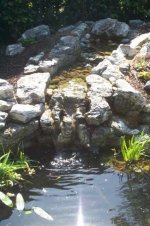Elizabeth Bigg
Addicted member
Recently we've been monitoring the pond area and the little cascade - the water bubbles up in a small pool at the top, and falls into a lower pool before returning to the pond. A favourite spot for drinking is the ledge where the water runs out of the top layer. Looking at the playback pictures, the following diiferent species visited to drink between 8am and 9am - wood pigeon, starling, blackbird, robin, siskin, goldfinch, dunnock, house sparrow and bluetit. The robin was the only one brave enough to take a bath! (Minimum temperature overnight was -4.4ºC and it was still below freezing at 9am).
Addition - I've just realised that I have a photo of the cascade. A picture is rather better than a description, I think.
Addition - I've just realised that I have a photo of the cascade. A picture is rather better than a description, I think.
Attachments
Last edited:




